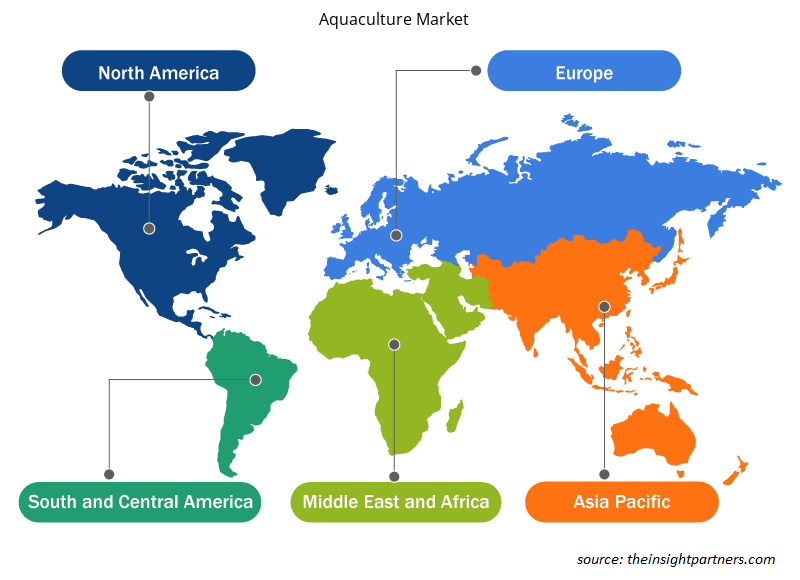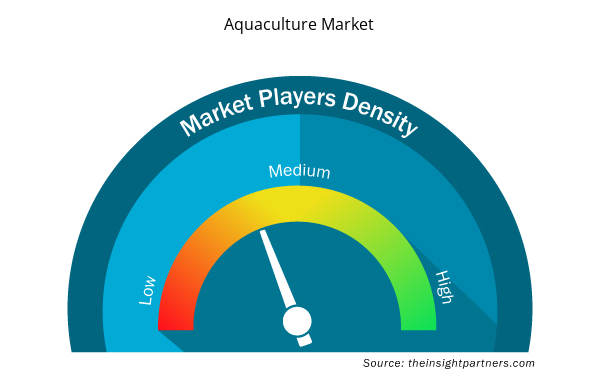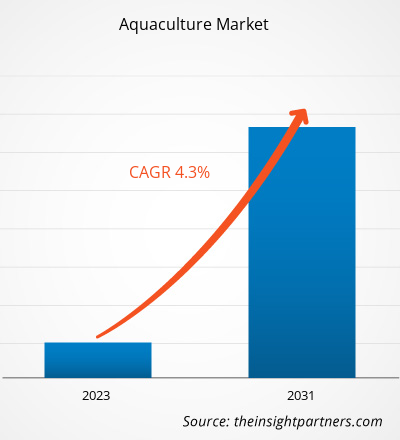水産養殖市場の規模は、2023年の4億644万米ドルから2031年には2,896.6億米ドルに達すると予測されています。市場は2023年から2031年にかけて4.3%のCAGRを記録すると予想されています。世界中で水を再利用して魚やその他の水生生物を養殖する循環型水産養殖システム(RAS)技術の導入が進んでおり、これが水産養殖市場の主要トレンドであり続けると思われます。
養殖市場分析
国連食糧農業機関(UN FAO)は、将来的に水産物の供給と需要の間にギャップがあることを認めています。2030年までに水産物の需要は2億6000万トンを超えると予測されており、現在の生産率による供給は2億1000万トンになると推定されています。したがって、養殖は水産物の需要増加を満たすための有力な手段であると考えられています。また、持続可能な環境のための水産物生産に関連する認証や基準はほとんどありません。世界自然保護基金(WWF)とオランダ持続可能な貿易イニシアチブ(IDH)は、2010年に水産養殖管理協議会(ASC)を設立しました。この協議会の目標は、世界の水産物市場を変革し、社会的な水産養殖のパフォーマンスを促進することです。
養殖市場の概要
養殖業には、魚、水生植物、藻類、甲殻類、軟体動物、その他の水生生物の養殖が含まれます。先進国および発展途上国の小規模養殖市場は、雇用に大きく貢献しています。国連食糧農業機関(FAO)によると、養殖業は世界中で4,100万人以上の雇用を生み出しています。魚介類の需要が高まっているため、発展途上国では養殖業の大部分が魚の生産に占められています。魚やその他の魚介類は、貧困線以下の人々にとって重要な栄養源であり、動物性タンパク質の中で最も安価な形態の1つです。人口増加、所得の増加、都市化の進展に伴って今後も増加し続ける魚の需要を満たすために、養殖業は重要な部門と考えられています。
要件に合わせてレポートをカスタマイズする
このレポートの一部、国レベルの分析、Excelデータパックなど、あらゆるレポートを無料でカスタマイズできます。また、スタートアップや大学向けのお得なオファーや割引もご利用いただけます。
- このレポートの主要な市場動向を入手してください。この無料サンプルには、市場動向から見積もりや予測に至るまでのデータ分析が含まれます。
養殖市場の推進要因と機会
魚介類の需要と消費の急増が市場を牽引
シーフード、特に魚は、多くの地域で伝統的な食べ物の一部です。また、魚は栄養価が高く、健康に良いことから広く消費されています。脂肪酸、ビタミン、ミネラル、タンパク質、必須微量栄養素の優れた供給源と考えられています。消費者の可処分所得と購買力の増加により、他の食品カテゴリーと比較して、シーフードなどの動物性タンパク質への支出も増加しています。現在、人口の急成長と健康的なタンパク質源としてのシーフードの人気の高まりにより、養殖市場の成長が促進されています。fuelled the growth of aquaculture market.
さまざまな産業における魚油の応用 - 水産養殖市場におけるチャンス
養殖は魚の生産に効果的な方法であり、環境的にも効果的で、小規模でも大規模でも運営できるため、コストも少なくて済みます。魚油の需要の急成長により、魚の生産量を増やす必要性が生じており、近い将来、養殖の需要が高まります。魚油は、主に栄養補助食品、ヘルスケア、製薬、食品業界で使用されています。魚油はビタミン A と D の効率的な供給源であり、野生の魚に次いで人間が消費する最も重要なビタミン源と考えられています。
水産養殖市場レポートのセグメンテーション分析
養殖市場分析の導出に貢献した主要なセグメントは、タイプとアプリケーションです。
- 製品タイプ別に見ると、市場は魚、水生植物、甲殻類、軟体動物、その他に分かれており、2023年には魚類セグメントが市場を支配しました。molluscs, and others. The fish segment dominated the market in 2023.
- 養殖環境に基づいて、養殖市場は淡水、海水、汽水に分けられます。2023年には海洋セグメントがより大きな市場シェアを占めました。
地域別養殖市場シェア分析
養殖市場レポートの地理的範囲は、主に北米、アジア太平洋、ヨーロッパ、中東およびアフリカ、南米/中南米の 5 つの地域に分かれています。
アジア太平洋地域の養殖市場は、ここ数年で大きな変化を遂げてきました。水産物の生産量と消費量は急速に拡大しており、養殖産業の主要市場は中国とインドです。アジア太平洋地域は、養殖製品の最大の消費者および輸出国として発展してきました。漁業と養殖生産は、アジア太平洋諸国の経済成長に大きく貢献する主要部門の 1 つです。ただし、南アジアおよび東南アジア諸国では、養殖生産の経済的貢献は小さくなっています。水産物は、アジア太平洋地域で最も取引される商品の 1 つであり、この地域に貴重な外貨獲得をもたらしています。過去数年間、インドやタイなどの発展途上国は魚の純輸出国となっており、同様の傾向により、今後数年間でアジア太平洋地域の養殖市場が拡大すると予想されています。
養殖市場の地域別洞察
予測期間を通じて水産養殖市場に影響を与える地域的な傾向と要因は、Insight Partners のアナリストによって徹底的に説明されています。このセクションでは、北米、ヨーロッパ、アジア太平洋、中東、アフリカ、南米、中米にわたる水産養殖市場のセグメントと地理についても説明します。

- 養殖市場の地域別データを入手
水産養殖市場レポートの範囲
| レポート属性 | 詳細 |
|---|---|
| 2023年の市場規模 | 4億644万米ドル |
| 2031年までの市場規模 | 2,896.6億米ドル |
| 世界のCAGR(2023年~2031年) | 4.3% |
| 履歴データ | 2021-2022 |
| 予測期間 | 2023-2031 |
| 対象セグメント | 製品タイプ別
|
| 対象地域と国 | 北米
|
| 市場リーダーと主要企業プロフィール |
|
水産養殖市場のプレーヤー密度:ビジネスダイナミクスへの影響を理解する
水産養殖市場は、消費者の嗜好の変化、技術の進歩、製品の利点に対する認識の高まりなどの要因により、エンドユーザーの需要が高まり、急速に成長しています。需要が高まるにつれて、企業は提供内容を拡大し、消費者のニーズを満たすために革新し、新たなトレンドを活用し、市場の成長をさらに促進しています。
市場プレーヤー密度とは、特定の市場または業界内で活動している企業または会社の分布を指します。これは、特定の市場スペースに、その規模または総市場価値と比較して、どれだけの競合相手 (市場プレーヤー) が存在するかを示します。
養殖市場で事業を展開している主要企業は次のとおりです。
- バッカフロスト
- ブルーリッジアクアカルチャー株式会社
- セルマックグループAS
- クック・アクアカルチャー社
- デンマークサーモンA/S
免責事項:上記の企業は、特定の順序でランク付けされていません。

- 水産養殖市場のトップキープレーヤーの概要を入手
養殖市場のニュースと最近の動向
水産養殖市場は、主要な企業出版物、協会データ、データベースなどの一次調査と二次調査を経て定性的および定量的データを収集することで評価されます。以下は、イノベーション、事業拡大、戦略に関する市場動向のリストです。
- 2021年6月、JBS SAはオーストラリア第2位のサーモン生産者であるHuon Aquacultureの100%を買収する契約を発表しました。これは戦略的買収であり、JBSが水産養殖事業に参入することを意味します。(出典:JBS SA、プレスリリース)
- 2022 年 1 月、Munkebo Seafood の買収により、Bakkafrost はより幅広い製品を提供できるようになりました。Bakkafrost は、生鮮、冷凍、スモークサーモン製品を提供しており、今回、缶詰食品が加わりました。Bakkafrost は世界的な販売ネットワークを持っており、Munkebo Seafood の製品は、Bakkafrost の他の消費者向けパッケージ製品の補足として、より広い市場で提供されるようになります。(出典: Bakkafrost、ニュースレター)
水産養殖市場レポートの対象範囲と成果物
「水産養殖市場の規模と予測(2023〜2031年)」レポートでは、以下の分野をカバーする市場の詳細な分析を提供しています。
- 対象範囲に含まれるすべての主要市場セグメントの世界、地域、国レベルでの市場規模と予測
- 市場の動向(推進要因、制約、主要な機会など)
- 今後の主な動向
- 詳細なPEST/ポーターの5つの力とSWOT分析
- 主要な市場動向、主要プレーヤー、規制、最近の市場動向を網羅した世界および地域の市場分析
- 市場集中、ヒートマップ分析、主要プレーヤー、最近の動向を網羅した業界の状況と競争分析
- 詳細な企業プロフィール
- 過去2年間の分析、基準年、CAGRによる予測(7年間)
- PEST分析とSWOT分析
- 市場規模価値/数量 - 世界、地域、国
- 業界と競争環境
- Excel データセット



Report Coverage
Revenue forecast, Company Analysis, Industry landscape, Growth factors, and Trends

Segment Covered
This text is related
to segments covered.

Regional Scope
North America, Europe, Asia Pacific, Middle East & Africa, South & Central America

Country Scope
This text is related
to country scope.
Trends and growth analysis reports related to Food and Beverages : READ MORE..
The Insight Partners performs research in 4 major stages: Data Collection & Secondary Research, Primary Research, Data Analysis and Data Triangulation & Final Review.
- Data Collection and Secondary Research:
As a market research and consulting firm operating from a decade, we have published and advised several client across the globe. First step for any study will start with an assessment of currently available data and insights from existing reports. Further, historical and current market information is collected from Investor Presentations, Annual Reports, SEC Filings, etc., and other information related to company’s performance and market positioning are gathered from Paid Databases (Factiva, Hoovers, and Reuters) and various other publications available in public domain.
Several associations trade associates, technical forums, institutes, societies and organization are accessed to gain technical as well as market related insights through their publications such as research papers, blogs and press releases related to the studies are referred to get cues about the market. Further, white papers, journals, magazines, and other news articles published in last 3 years are scrutinized and analyzed to understand the current market trends.
- Primary Research:
The primarily interview analysis comprise of data obtained from industry participants interview and answers to survey questions gathered by in-house primary team.
For primary research, interviews are conducted with industry experts/CEOs/Marketing Managers/VPs/Subject Matter Experts from both demand and supply side to get a 360-degree view of the market. The primary team conducts several interviews based on the complexity of the markets to understand the various market trends and dynamics which makes research more credible and precise.
A typical research interview fulfils the following functions:
- Provides first-hand information on the market size, market trends, growth trends, competitive landscape, and outlook
- Validates and strengthens in-house secondary research findings
- Develops the analysis team’s expertise and market understanding
Primary research involves email interactions and telephone interviews for each market, category, segment, and sub-segment across geographies. The participants who typically take part in such a process include, but are not limited to:
- Industry participants: VPs, business development managers, market intelligence managers and national sales managers
- Outside experts: Valuation experts, research analysts and key opinion leaders specializing in the electronics and semiconductor industry.
Below is the breakup of our primary respondents by company, designation, and region:

Once we receive the confirmation from primary research sources or primary respondents, we finalize the base year market estimation and forecast the data as per the macroeconomic and microeconomic factors assessed during data collection.
- Data Analysis:
Once data is validated through both secondary as well as primary respondents, we finalize the market estimations by hypothesis formulation and factor analysis at regional and country level.
- Macro-Economic Factor Analysis:
We analyse macroeconomic indicators such the gross domestic product (GDP), increase in the demand for goods and services across industries, technological advancement, regional economic growth, governmental policies, the influence of COVID-19, PEST analysis, and other aspects. This analysis aids in setting benchmarks for various nations/regions and approximating market splits. Additionally, the general trend of the aforementioned components aid in determining the market's development possibilities.
- Country Level Data:
Various factors that are especially aligned to the country are taken into account to determine the market size for a certain area and country, including the presence of vendors, such as headquarters and offices, the country's GDP, demand patterns, and industry growth. To comprehend the market dynamics for the nation, a number of growth variables, inhibitors, application areas, and current market trends are researched. The aforementioned elements aid in determining the country's overall market's growth potential.
- Company Profile:
The “Table of Contents” is formulated by listing and analyzing more than 25 - 30 companies operating in the market ecosystem across geographies. However, we profile only 10 companies as a standard practice in our syndicate reports. These 10 companies comprise leading, emerging, and regional players. Nonetheless, our analysis is not restricted to the 10 listed companies, we also analyze other companies present in the market to develop a holistic view and understand the prevailing trends. The “Company Profiles” section in the report covers key facts, business description, products & services, financial information, SWOT analysis, and key developments. The financial information presented is extracted from the annual reports and official documents of the publicly listed companies. Upon collecting the information for the sections of respective companies, we verify them via various primary sources and then compile the data in respective company profiles. The company level information helps us in deriving the base number as well as in forecasting the market size.
- Developing Base Number:
Aggregation of sales statistics (2020-2022) and macro-economic factor, and other secondary and primary research insights are utilized to arrive at base number and related market shares for 2022. The data gaps are identified in this step and relevant market data is analyzed, collected from paid primary interviews or databases. On finalizing the base year market size, forecasts are developed on the basis of macro-economic, industry and market growth factors and company level analysis.
- Data Triangulation and Final Review:
The market findings and base year market size calculations are validated from supply as well as demand side. Demand side validations are based on macro-economic factor analysis and benchmarks for respective regions and countries. In case of supply side validations, revenues of major companies are estimated (in case not available) based on industry benchmark, approximate number of employees, product portfolio, and primary interviews revenues are gathered. Further revenue from target product/service segment is assessed to avoid overshooting of market statistics. In case of heavy deviations between supply and demand side values, all thes steps are repeated to achieve synchronization.
We follow an iterative model, wherein we share our research findings with Subject Matter Experts (SME’s) and Key Opinion Leaders (KOLs) until consensus view of the market is not formulated – this model negates any drastic deviation in the opinions of experts. Only validated and universally acceptable research findings are quoted in our reports.
We have important check points that we use to validate our research findings – which we call – data triangulation, where we validate the information, we generate from secondary sources with primary interviews and then we re-validate with our internal data bases and Subject matter experts. This comprehensive model enables us to deliver high quality, reliable data in shortest possible time.


 このレポートの無料サンプルを入手する
このレポートの無料サンプルを入手する